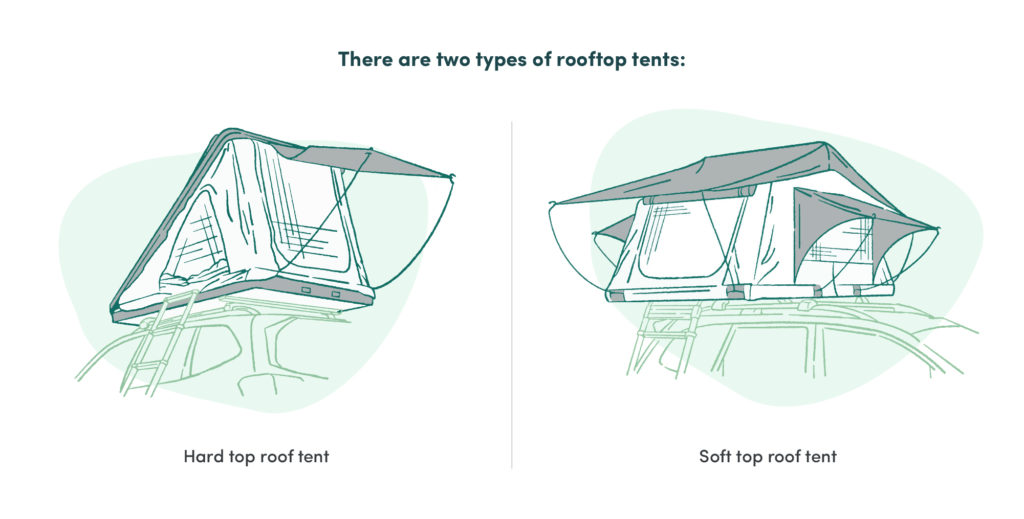A rooftop tent is exactly what it sounds like — a tent that attaches to, you guessed it, the roof of your vehicle. These little babies pop up or fold out from the top of a vehicle. You can buy or rent one separately and have it attached to your personal vehicle, or you can rent a vehicle with one already attached — Score!
Whether you decide to buy a rooftop tent or rent a rooftop tent rig, we’re here to walk you through it!

How It Works
Let’s break it down.
Tent Types
There are two types of rooftop tents:
- Soft-top
- Hard-shell

Soft-Top Tents
Soft-tops look a lot like your average tent with their triangular shape and the pole system setup, but the canvas material is typically heavier.
Hard-Shell Tents
Mostly made of fiberglass, hard-shells fold down into a compact rectangle atop your vehicle, and fold up to form your home on the road.

Installation
Rooftop tents can be installed on all roof racks, whether flat racks, crossbars, or a canopy. Be sure to check the Dynamic Weight Capacity (DWC) of your racks. The DWC will tell you what weight the rack can carry while your vehicle is in motion. The DWC should be at least the weight of your tent.
How to Install
Installing a rooftop tent can be done in less than an hour with two or more people. You’ll receive installation instructions with your tent purchase or from the owner if you’re renting, but we’ve broken it down into 11 general steps.
- Get your tools and workspace ready.
- Inspect the roof rack.
- Attach the mounting tracks.
- Secure the mounting tracks
- Connect the ladder to the tent.
- Secure the ladder to the ladder brackets.
- Put the tent cover on.
- Place the tent on top of your vehicle.
- Position the tent and slide it on.
- Secure it to the roof rack.
- Install mounting rack end caps.
It’s all a matter of some bolts, a couple of clips, a few latches, and ta-da! Once it’s installed and secured to your roof, setting it up at your campsite is a breeze — a 2-minute breeze.
Vehicles that Support Rooftop Tents
Technically speaking, a rooftop tent will work on any vehicle; however, your car may not necessarily be ideal for the setup. Why? Mainly because of the extra weight that will be sitting on top of your roof.
These tents weigh anywhere from 100 to over 200 pounds. Additionally, they need to be set up on roof racks, which is just more added weight on the roof of your car. The smaller and less powerful your ride is, the more this added weight will affect things like speed and acceleration.
That said, the most suitable vehicles for the rooftop tent is a truck, SUV, or something larger.


3 Things to Know Before You Go
1. Terrain matters.
Before setting up camp, park on level terrain. Parking on an uneven surface can lead to a bad night’s sleep.
2. Plan for less mobility.
It’s time-consuming to take your campsite apart once set up. You can still pick up and go whenever you want, just expect to take some extra time to put everything away. It may be best to explore on foot or via public transport in some cases.
3. Expect the effects of extra weight.
The tent plus the roof rack, full water and gas tanks, and any extra gear adds up. This added weight can throw off the vehicle’s center of gravity and create wind resistance that, as mentioned before, will reduce performance.
Elevate Your Camping
Ready to elevate your camping experience to your car roof? Try out a rooftop tent. They’re comfortable, convenient, and perfect for taking your campsite to new heights!








